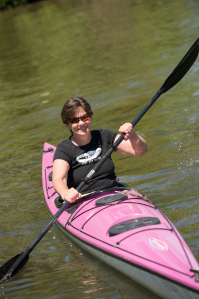Advice for beginning kayakers

Sarah Martin is one with her kayak.
“I love to be in nature. I love the peacefulness of it. When you are out on a body of water, your problems are so far away from you. For me, it‘s spiritual,” Martin says. She works at Upstate University Hospital at the Community campus.
Martin is an experienced boater who discovered as she got older that she preferred boats without motors. She bought her lilac kayak a couple years ago and quickly became an enthusiastic disciple of kayaking.
She tells people who are interested in joining the activity:
1. Get the best kayak you can afford. You can get a molded plastic one for probably $600. I would suggest going to a kayak specialty store. This one was probably $1,800 used. It would have been $2,300 new.
2. The longer your kayak, the more stable it will be. Shorter kayakers are for the more advanced. Kayaks are pretty sturdy. I bought this particular kayak because I wanted to learn how to roll it. I have yet to master that. It‘s very difficult to get it to roll. The biggest thing is getting in and out of it; you may end up in the water.
3. Paddles make a huge difference in fatigue level and overall maneuverability of the boat. Get the lightest one you can find.
4. I wear a dry suit, especially in the spring when the water is still cold. I bring my phone, something to drink and a rain jacket to keep in a little porthole right in front of me. Also, I keep flotation gear in the boat with me.


